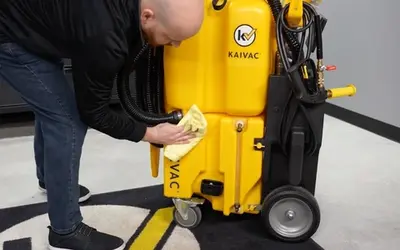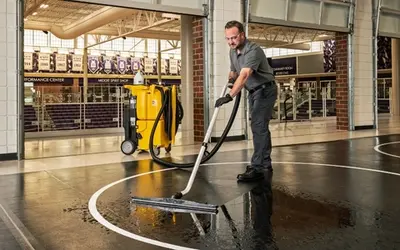Preparing to Reopen Schools: Cleaning Tips to Keep Schools Safe

In 2020, The Washington Post reports that 43 states, plus the District of Columbia have ordered or recommended that schools remain closed this spring. In-person summer school is still up in the air.
But schools will certainly start to reopen. Just don’t expect it to look like it used to. The new normal will most likely include novel protocols like half-filled busses, staggered start times, empty cafeterias and desks placed six feet apart.
And cleaning. Lots and lots of cleaning.
The CDC has released several documents, charts and tools to guide opening as safely as possible. They all stress that intensified cleaning and disinfection efforts will play and enormous role in keeping everyone safe.
Cleaning and disinfecting in K-12 schools should focus on touch points. But everything is a touch point at school, particularly when younger students come back. This means cleaning has to be vigilant and ongoing. But it doesn’t have to be backbreaking or time consuming.
As administrators, teachers and maintenance staff adjust to new protocols here’s cleaning tips to keep everyone safe and sane.
COVID-19: What Decreases Risk, What Kills the Virus
COVID-19, like other coronavirus, don’t live on surfaces indefinitely. They also die faster in warmer temperatures or when exposed to sunlight. Because of this, the CDC recommends using only soap and water on infrequently touched areas and outdoor spaces.
The organization also stresses that interiors that have been unoccupied for seven days or more will only need normal, routine cleaning before reopening. ‘This is because the virus that causes COVID-19 has not been shown to survive on surfaces longer than this time,’ according to reopening guidance documents.
Disinfecting: The Soft Surface Dilemma
Schools, particularly elementary schools, often contain rugs, pillows, toys and lots of other soft, porous materials. While warm and comforting, these items are not as easy to clean and disinfect as hard and non-porous surfaces. The EPA has listed a limited number of products approved for disinfection for use on soft and porous materials. However, if it is possible, the CDC is recommending storing these objects for now.
Touch Points: The Highest Priority
The list of hard, non-porous touch points in a school seems endless. The CDC put out a partial list that includes:
- tables,
- doorknobs,
- light switches,
- countertops,
- handles,
- desks,
- phones,
- keyboards,
- toilets,
- faucets and sinks,
- touch screens
All of these surfaces will require cleaning and disinfecting throughout the day. Supplying classroom teachers with disinfecting wipes will help make the job a bit easier. They can also use microfiber towels or dry disposable wipes and disinfecting sprays. As always, it is critical to clean properly before applying disinfectant. Be sure to instruct teachers on correct methods to avoid cross-contamination. Click here to learn the safest way to use this technology.
Daily Cleaning and Disinfecting: Smarter not Harder
Routine cleaning and disinfecting will play a huge role in reducing the risk of infection in schools. But the increased schedule doesn’t have to mean harder work for maintenance staff. There are techniques and technologies available to remove dirt, germs and pathogens quickly and completely.
Take desks, for instance. Probably a new addition to the daily cleaning checklist, desks are the ultimate touch point. Cleaning them with a towel or rag and lots of elbow grease, however, is time consuming and hard on workers backs and shoulders.
Technology like the KaiFly system changes that. A combination of microfiber, squeegee and chemical injection, the KaiFly eliminates dirt and germs in half the time of traditional rags and towels. The ergonomic design relieves stress to worker’s shoulders and backs. And the system maintains cleaning effectiveness, so the last desk maintained is as clean as the first.
Hard floors should also receive daily attention, but not with a mop. Mops and buckets are better at spreading dirt and germs around than actually removing them. In fact, mops only remove about 50% of bacteria and damp mop heads provide cozy breeding grounds for bacteria.
Autoscrubbers do a better job, but they are expensive to buy, hard to use and break down a lot.
There is a way to remove dirt and pathogens quickly and completely, without an expensive initial investment. Kaivac’s hard surface floor cleaning machines offer solutions for every kind of hard floor type, texture and configuration. They are easy to learn, work quickly and leave floors dry and ready to walk on, so maintenance staff can cover a lot of square footage every single night.
School restrooms should be cleaned and disinfected daily. But again, not with a mop. This high-risk environment is the primary source of bacteria and germs in a building and studies show that many of those pollutants ultimately make their way through the rest of the facility.
A Kaivac system removes those dangerous soils in about a third of the time of standard cleaning devices. Floors, walls and fixtures can be clean, dry and ready to use quickly. And because they are No-Touch maintenance staff reduces their own risk to exposure.
For information about how Kaivac works with K-12 school districts and many colleges and universities to clean and disinfect so schools can reopen and operate safely.
Related Posts

Preventive Maintenance for Your No-Touch Cleaning® System
Your Kaivac No-Touch Cleaning system makes restroom maintenance fast and easy. Keeping your No-Touch Cleaning system in good working order is also fast and easy. Kaivac makes performing preventative maintenance and troubleshooting potential issues simple. No special equipment or technical expertise required.
Read more
A Cleaning Lesson from Schools and Universities that Rely on Kaivac Systems
School, college, and university facilities departments from around the country love their Kaivac Cleaning Systems. Why wouldn’t they? Designed with the custodial worker in mind, these tools and processes from Kaivac are easy to master, work super-fast, and deliver exceptionally clean, fresh-smelling spaces.
Read more
Reduce Absenteeism Through Better School Cleaning
K-12 school leaders are coming up with a variety of ways to combat chronic absenteeism. Strategies like offering in-school laundry services and basic health care show a lot of promise. But providing better cleaning may be one of the most effective, most cost-efficient tactics available.
Read more